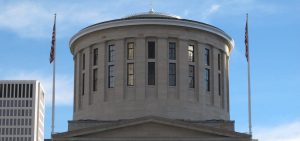News
Unprecedented Ohio legislative primary on August 2 will likely go mostly unnoticed
By: Karen Kasler | Statehouse News Bureau
Posted on:
COLUMBUS, Ohio (Statehouse News Bureau) — Nearly 1,300 candidates will vie for the chance to represent their parties this fall in a vote that usually happens in March or May, but the redistricting saga that’s dragged on for almost a year scratched that vote.

“This has been a dumpster fire, a train wreck, whatever, you know, whatever description you want to call it,” said David Brian Cohen is a political science professor and the Director of the Applied Politics Program at the University of Akron’s Bliss Institute.
Like many Ohioans, he’s frustrated with the process of redrawing Ohio’s legislative district maps. All five set of maps approved by Republicans on the Ohio Redistricting Commission were ruled unconstitutionally gerrymandered by the Ohio Supreme Court. The maps in use for this primary and the general election this fall were ordered by a federal court after some Republican voters filed a lawsuit over the redistricting process. The whole situation has Cohen concerned.
“It’s not good for democracy. It’s it’s a stain on Ohio’s political history. And I think that it’s going to result in record low turnout in in August,” Cohen said.
The record for low turnout in an Ohio primary was set in May 2016, with just under 17% of voters casting ballots. 20.8% of voters turned out this May.
House Minority Leader Allison Russo said she expects this abbreviated August primary could have even lower numbers.
“It’s going to cost us anywhere from $20 to $25 million extra tax burden to the taxpayers of Ohio,” Russo said. “A ton of confusion, even for people who are very engaged with what is happening. They don’t know what their district is. They’ve forgotten that there’s a primary. A lot of people are on vacation. So we anticipate the turnout’s probably going to be somewhere around 5% or less.”
Voters aren’t the only ones who’ve been confused, said Republican consultant Bob Clegg. So are candidates who didn’t know where their districts were when they filed, and those who had to move when their districts changed, and those who now don’t know how to target the voters they need to turn out.
“How do we know who’s going to vote in this election, number one? Because you can’t look at past primaries that were held in either March or May. We’ve never had a statewide primary in August that I can think of,” Clegg said. “So I don’t know what you would look at to try to get a sense of who’s going to turn out.”
The 99 House and 17 Senate races on this ballot include some former lawmakers are hoping to return to the Statehouse: for instance, ex-Rep. John Barnes Jr., running against fellow Democrat and current Rep. Kent Smith (D-Euclid) for an eastern Cleveland Senate seat. Barnes is endorsed by a pro-school choice group Clegg is working for, which is backing a number of Republicans as well.
“Republicans turned out at a much higher level here in Ohio than Democrats did in May. But it’s not going to be that way in August,” Clegg said. “A good portion of those voters will be party activists on both sides because they’re the ones that are fully aware.”
Republicans have supermajorities in both the House and Senate. These maps were drawn to split the Statehouse 54% Republican, 46% Democratic. There are 19 House districts and 7 Senate districts that are considered toss ups on the November ballot, with Democrats thought to have less than a 2 point advantage in those districts.
But there are only a few close races in this primary. Several incumbents in safe seats for the fall have primary challengers. One potential toss-up seat for the fall has moderate Republican Sen. Nathan Manning (R-North Ridgeville) facing a challenge from his right from state board of education member Kristin Hill, who’s campaigning against so-called critical race theory in K-12 education and promising to co-sponsor a bill to ban mandatory vaccines and masks in schools.
And there will be one less incumbent in the House Democratic caucus, with Democratic Reps. Monique Smith (D-Westlake) and Bride Rose Sweeney (D-Cleveland) drawn into the same western Cleveland district.
Russo declined to get involved in that battle, and says she’s worried about a bigger picture.
“This is really about which candidate, Republican or Democrat, can turn out voters. And that often requires resources and who has the resources. Often the incumbents are in the best position to have the resources to make that happen,” Russo said. “But really, at the end of the day, my concern, even though I am the minority leader, is less about the impact on incumbents. This is really, to me, a disservice to voters.”
A week before the August 2 primary, the secretary of state’s office reports 67,218 early absentee ballots have been cast, a quarter of the number of votes cast early in the May primary.
9(MDU1ODUxOTA3MDE2MDQwNjY2NjEyM2Q3ZA000))

